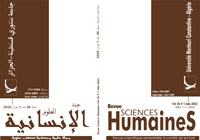دور رجال الدين في خلق نموذج للأنوثة الخاضعة في العمل الخيري في بريطانيا في القرن التاسع عشر
الكلمات المفتاحية:
رجال الدين، المعايير الذكورية، العمل الخيري، خضوع، النساءالملخص
تشير هذه الدراسة إلى أن رجال الدين في بريطانيا في القرن التاسع عشر دعموا مشاركة النساء في الأعمال الخيرية لتنمية نموذج خاضع وراعي للأنوثة يكمل المعايير الذكورية الأبوية. ورغم أن بعض المؤرخين زعموا أن المسيحية لعبت دوراً حاسماً في تشكيل التجربة الاجتماعية للنساء، فإن هذه المقالة تطرح بعض الحجج لإثبات العكس. من خلال التعمق في العقيدة المسيحية، روّج العديد من رجال الدين لفكرة مفادها أن النساء خاضعات بشكل طبيعي للرجال، سواء في الأسرة أو في المجتمع. وقد عزز هذا التفسير الأبوي للتعاليم الدينية فكرة أن الفضائل الأساسية للمرأة هي التقوى والتواضع والخضوع، والتي كانت غالبًا ما تنسج في التوقعات الموضوعة على النساء المشاركات في الجهود الخيرية. وعلاوة على ذلك، فقد صاغوا نموذجًا للعمل الخيري الأنثوي الذي أكد على الخضوع والواجب الأخلاقي على الاستقلال والتغيير الاجتماعي، مما أبقى النساء داخل إطار منعهن من تحدي الهياكل الأبوية الأوسع في ذلك الوقت. وأظهر التحليل أن رجال الدين اعتبروا العمل الخيري الذي تقوم به النساء عملاً فاضلاً، ولكنهم في الوقت نفسه عززوا المعايير المجتمعية التي تحد من استقلالهن وتعزز من وضعهن التابع.
التنزيلات
المراجع
[1]. Brown, Beatrice Curtis. (1960). Isabel Fry: Portrait of a Great Teacher. London: Arthur Barker.
[2]. Burgan, Mary. (1986). “Heroines at the Piano: Women and Music in Nineteenth-Century Fiction”. Victorian Studies, 30(1), 51–76. http://www.jstor.org/stable/382819
[3]. Burgess, Henry. (1958). Enterprise in Education: The Story of the Work of the Established Church in the Education of the People prior to 1870. London: London University Press.
[4]. Elliott, Williams. (2002). The Angel out of the House: Philanthropy and Gender in Nineteenth-Century England. University of Virginia Press.
[5]. Fee, E., & Garofalo, M. E. (2010). “Florence Nightingale and the Crimean War.” American Journal of Public Health, 10(7), 1591.
[6]. Grimshaw, Jean. (1992). “The Idea of a Female Ethic. Philosophy East and West”, 42(2), 221–238. https://doi.org/10.2307/1399287
[7]. Groothuis, Rebecca Merrill. (1997). Good News for Women: A Biblical Picture of Gender Equality. Baker books.
[8]. Hall, Catherine. (1992). Private Persons versus Public Someone’s: Class, gender and politics in England, 1780-1850. Cambridge: Polity.
[9]. Hansan, J.E. (2013). Charity Organization Societies (1877 – 1893). Social Welfare History Project. Taken from https://socialwelfare.library.vcu.edu/eras/civil-war-reconstruction/charity-organization-societies-1877-1893/
[10]. Hempton, David. (1996). The Religion of the People: Methodism and Popular Religion, 1750- 1900. London: Routledge.
[11]. Lamonaca, Maria. (2002). “Jane’s Crown of Thrones: Feminism And Christianity in “Jane Eyre.” Studies in the Novel, 34(3), 245–263. http://www.jstor.org/stable/29533514
[12]. Luddy, Maria. (1996). “Women and philanthropy in nineteenth-century Ireland. Voluntas: International Journal of Voluntary and Nonprofit Organizations.” 7(4), 350–364. http://www.jstor.org/stable/27927533
[13]. Philanthropy in 19th Century Britain – Humble Beginnings. History is Now. http://www.historyisnowmagazine.com/blog/2014/6/19/philanthropy-in-19th-century-britain-humble-beginnings
[14]. Prochaska, Frank. (1981). “Female Philanthropy and Domestic Service in Victorian England”. Historical Research 54.129 (1981): 79. Web.
[15]. _____. (1988). The Voluntary Impulse. Philanthropy in Modern Britain. London: London University Press.
[16]. Pink, Sarah. (2004). Home Truths: Gender, Domestic Objects and Everyday Life. New York: Berg.
[17]. Scheinberg, Cynthia. (2002). Women's Poetry and Religion in Victorian England: Jewish Identity and Christian Culture. Cambridge, England: Cambridge University Press.
[18]. Schraedel, Jolyn. (2023). Understanding Gendered Hierarchy in Highly Religious Couples. Theses and Dissertations. 9916. https://scholarsarchive.byu.edu/etd/9916
[19]. Schwartz, Laura. (2013). Infidel Feminism: Secularism, Religion and Women's Emancipation, England 1830-1914. Oxford: Manchester University Press.
[20]. Severson, Nicolette. (2014). “Devils Would Blush to Look”: Brothel Visits of the New York Female Moral Reform Society, 1835 and 1836. Journal of the History of Sexuality, 23(2), 226–246. http://www.jstor.org/stable/24616491
[21]. Sider, R. J. (1985). “AN EVANGELICAL VISION FOR PUBLIC POLICY”. Transformation, 2(3), 1–9. http://www.jstor.org/stable/43052110
[22]. Smith, Mark K. (2008). Octavia Hill: Housing, Space and Social Reform, The encyclopedia of informal education.
[23]. Stephens, Morgan. (2023). Angela Burdett-Coutts: a legacy of education, Royal Institution, taken from: https://www.rigb.org/explore-science/explore/blog/angela-burdett-coutts-legacy-education
[24]. Stickney, Sara. (1843). The Wives of England: Their Relative Duties, Domestic Influence, and Social Obligations. London: Fisher, son, & co.
[25]. Strachey, Ray. (1978). The Cause, A Short History of the Women's Movement in Great Britain. London: Virago.
[26]. Thormahlen, Marianne. (1999). The Brontë’s and Religion. Cambridge, England: Cambridge University Press.
[27]. Zigan, K., & Le Grys, A. (2018). “Towards an Understanding of Social Responsibility Within the Church of England. Journal of Business Ethics”, 149(3), 535–560. http://www.jstor.org/stable/45022503
[28]. W. M. Jacob. (2021). Religious Vitality in Victorian London. Oxford: Oxford University Press.
التنزيلات
منشور
إصدار
القسم
الرخصة
الحقوق الفكرية (c) 2025 مجلة العلوم الإنسانية

هذا العمل مرخص بموجب Creative Commons Attribution-NonCommercial 4.0 International License.












